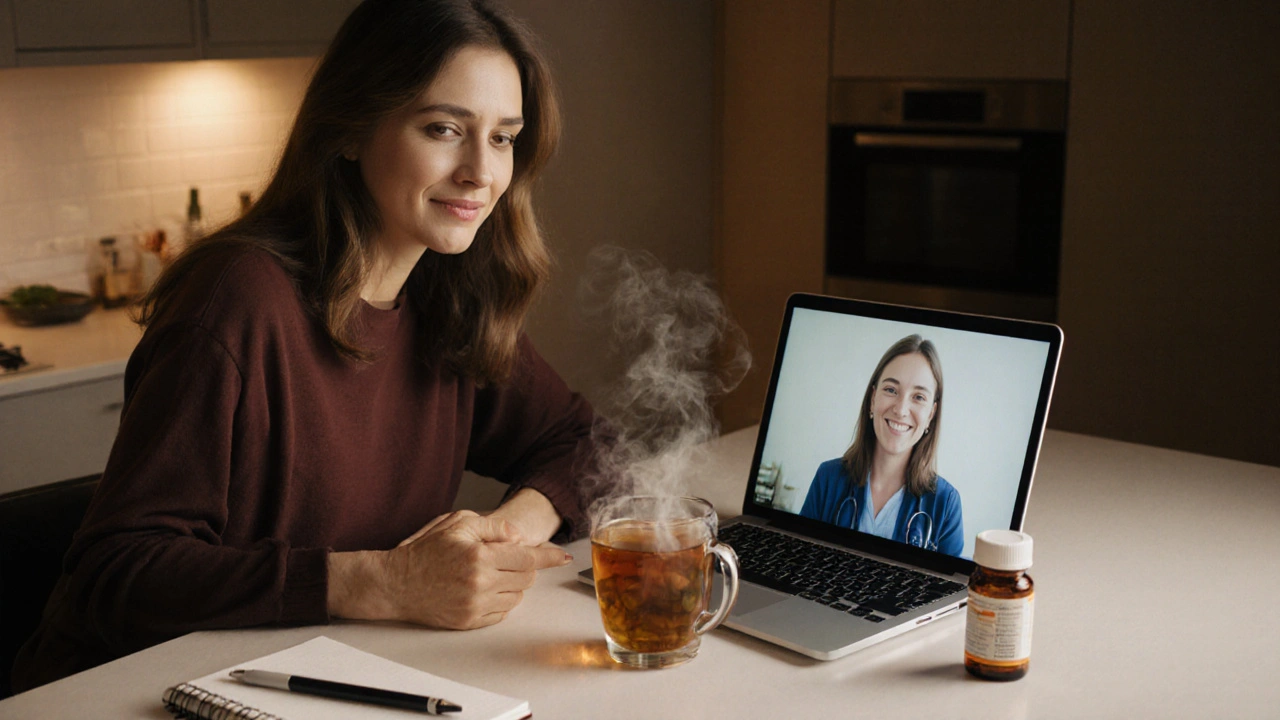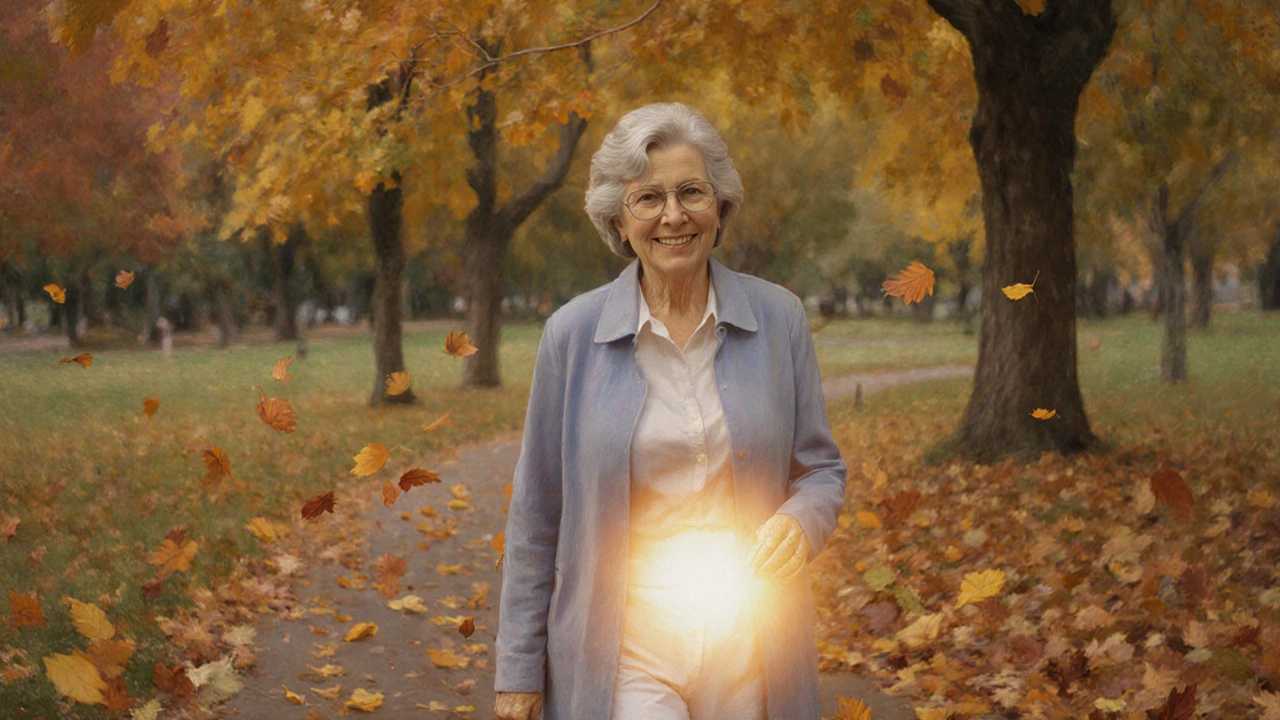How Age Affects Ovulation and Menstruation Regulation
 Sep, 30 2025
Sep, 30 2025
Age & Hormone Impact Calculator
Enter your age and symptoms to estimate how it may affect your ovulation and menstrual cycle.
Quick Summary
- Age reshapes the hormonal signals that drive age and ovulation and the menstrual cycle.
- Puberty, the reproductive years, perimenopause, and menopause each have distinct hormone patterns.
- FSH, LH, and estrogen levels rise, fall, or become erratic as women age, affecting cycle regularity and fertility.
- Lifestyle factors-nutrition, stress, sleep-can buffer or amplify age‑related changes.
- Medical options like hormonal therapy or fertility preservation help manage age‑linked disruptions.
What Happens When We Talk About Ovulation, Menstruation, and Age?
When we talk about Ovulation is the release of a mature egg from the ovary, typically around the middle of the menstrual cycle, we’re looking at a tightly timed event driven by the brain and the ovaries. Menstruation is the shedding of the uterine lining when an egg isn’t fertilized, marking the end of one cycle and the start of the next. Both processes are orchestrated by the Hypothalamic‑Pituitary‑Ovarian (HPO) axis is a feedback loop where the hypothalamus releases GnRH, prompting the pituitary to secrete FSH and LH, which then act on the ovaries to produce estrogen and progesterone.
Age is the cumulative number of years a person has lived, which influences physiological systems through genetic, environmental, and hormonal pathways. As a woman moves from puberty through the reproductive span and into perimenopause and menopause, the HPO axis undergoes gradual but measurable shifts.
Hormonal Landscape at Different Life Stages
Understanding how age affects the cycle starts with a snapshot of hormone levels at four key phases.
| Life Stage | FSH (mIU/mL) | LH (mIU/mL) | Estradiol (pg/mL) | Cycle Length |
|---|---|---|---|---|
| Puberty (≈12‑15y) | 5‑15 | 4‑12 | 30‑150 | Irregular, then settles at 28‑35days |
| Reproductive Years (20‑35y) | 3‑10 | 5‑20 | 150‑400 | Regular 21‑35days |
| Perimenopause (45‑55y) | 15‑30+ | 10‑25+ | 30‑150 (fluctuating) | Variable, often >35days |
| Menopause (≈51y avg.) | 30‑100+ | 20‑70+ | <20 | No periods |
Why Hormones Change With Age
Several mechanisms explain the shift.
- Ovarian reserve depletion: The finite pool of follicles dwindles, leading to lower estrogen output and less feedback inhibition on the pituitary.
- Altered GnRH pulsatility: The hypothalamus fires GnRH less consistently, which translates into erratic FSH/LH spikes.
- Changes in metabolic health: Body fat distribution, insulin sensitivity, and inflammation all influence estrogen conversion (via aromatase) and can speed up or delay cycle changes.
When estrogen falls, the pituitary ramps up Follicle‑Stimulating Hormone (FSH) is a hormone that promotes growth of ovarian follicles and prepares the egg for release. Higher FSH is a hallmark of the transition to perimenopause. Likewise, Luteinizing Hormone (LH) is the trigger for ovulation and later the formation of the corpus luteum can become more erratic, causing missed or delayed ovulation.

Clinical Manifestations: What Women Notice
Age‑related hormonal drift shows up in three main ways.
- Cycle length variability: Periods may stretch beyond 35days, skip, or become heavier.
- Reduced fertility: Egg quality declines, and irregular ovulation makes timing intercourse harder.
- Symptoms of estrogen deficiency: Hot flashes, night sweats, mood swings, and vaginal dryness often appear during perimenopause.
These signs are not uniform-genetics, lifestyle, and underlying health conditions create wide individual differences.
Lifestyle Levers to Support Hormonal Balance
While aging is inevitable, certain habits can smooth the hormonal ride.
- Nutrition: Foods rich in phytoestrogens (like soy, flaxseed, and legumes) provide mild estrogenic activity that may ease the drop.
- Exercise: Weight‑bearing and strength training preserve bone density and improve insulin sensitivity, both of which support steady estrogen production.
- Sleep hygiene: Adequate REM sleep normalizes GnRH pulsatility; aim for 7‑9hours.
- Stress management: Chronic cortisol can suppress the HPO axis; mindfulness, yoga, or short breaks help.
- Body weight: Maintaining a BMI between 20‑25 reduces aromatase‑driven excess estrogen that can disrupt cycles.
Medical Options When Natural Strategies Aren’t Enough
Doctors have several tools to address age‑related irregularities.
- Hormone Replacement Therapy (HRT): Low‑dose estrogen (often combined with progesterone) can relieve vasomotor symptoms and stabilize the endometrium.
- Selective Estrogen Receptor Modulators (SERMs): Medications like raloxifene act as estrogen agonists in bone but antagonists in breast tissue, useful for women at risk for hormone‑sensitive cancers.
- Fertility preservation: Egg freezing before the mid‑30s captures higher‑quality oocytes for later use.
- Ovulation induction: Letrozole or clomiphene can stimulate the ovary when natural cycles become too erratic.
Each option carries benefits and risks; shared decision‑making with a reproductive endocrinologist is key.
What to Expect After Menopause
Once the ovaries stop producing measurable estrogen, the HPO axis enters a low‑activity state. FSH and LH remain elevated because the negative feedback loop is gone. The body then relies on peripheral conversion of adrenal androgens to estrogen (via aromatase in fat tissue) for modest hormone activity. This shift explains why post‑menopausal women with higher body fat often report fewer hot flashes but face greater long‑term cardiovascular and cancer risks.
Key Takeaways
Age is the master regulator of ovulation and menstruation through its impact on the HPO axis, ovarian reserve, and systemic metabolism. Recognizing the stages-from puberty’s first cycles to the gradual decline of perimenopause-helps women anticipate changes, adopt supportive lifestyle habits, and seek medical guidance when needed.

Frequently Asked Questions
Why do my periods become irregular in my 40s?
Irregularity usually signals the start of perimenopause. The ovarian reserve is shrinking, so estrogen spikes become less predictable, and the pituitary compensates by releasing more FSH and LH, leading to longer or missed cycles.
Can I still get pregnant after 40?
Yes, but fertility declines sharply after 35. Egg quality drops, and ovulation may be less consistent. Consulting a fertility specialist for timing strategies or considering egg freezing earlier can improve chances.
Is hormone replacement therapy safe?
For most healthy women, low‑dose HRT reduces hot flashes and protects bone density. Risks include a slight increase in breast cancer and blood clotting, especially with estrogen‑only formulations. A personalized risk assessment is essential.
Do phytoestrogens really help with menopause symptoms?
Studies show modest relief of mild hot flashes for women who consume soy or flaxseed daily. They aren’t a substitute for prescription therapy but can be a useful dietary adjunct.
How can I tell if I’m truly in menopause?
Clinically, menopause is diagnosed after 12 consecutive months without a period and confirmed by elevated FSH (>30mIU/mL) and low estradiol (<20pg/mL). Your doctor can run these labs to confirm.
Crystal Newgen
September 30, 2025 AT 13:13Age really shifts the hormone balance, so the cycles change.
Hannah Dawson
October 4, 2025 AT 00:33The calculator sounds slick, but the logic behind those hormone ranges is oversimplified.
It lumps together ages that have wildly different endocrine profiles, which could mislead users.
A 25‑year‑old and a 45‑year‑old have distinct follicular dynamics, yet the tool treats them almost identically.
Readers should double‑check any output with a clinician.
Julie Gray
October 7, 2025 AT 11:53One must consider the broader sociopolitical context in which such health calculators emerge. The data sources are rarely disclosed, raising concerns about undisclosed sponsorships. Moreover, the algorithm may embed subtle biases that prioritize certain demographics. It is prudent to remain vigilant and question the provenance of the numbers presented.
Lisa Emilie Ness
October 10, 2025 AT 23:13Helpful tip: track your cycle for a few months before trusting any tool.
Emily Wagner
October 14, 2025 AT 10:33From a systems‑theory perspective, age is a primary axis that modulates endocrine feedback loops. The hormonal milieu transitions from a state of plasticity in adolescence to a relatively stable plateau in the twenties, then gradually desensitizes approaching perimenopause. When you feed a single age value into a static calculator, you ignore the stochastic variability inherent in luteal phase function. In practice, integrating symptom tracking with hormonal assays yields a richer, more nuanced picture of reproductive health.
Mark French
October 17, 2025 AT 21:53It is essential to understand that ovarian reserve diminishes with age, which can alter both the length and regularity of cycles. While the calculator provides a baseline, individual variation is inevitable. If you notice significant deviations, consider consulting a specialist – they can run a FSH or AMH test for a more accurate assessment. Remember, "age is just a number" but in reproductive physiology, it does matter.
Daylon Knight
October 21, 2025 AT 09:13Oh great, another "one‑size‑fits‑all" widget that thinks it can predict your hormones. Sure, because biology is that simple, right?
Jason Layne
October 24, 2025 AT 20:33Listen, the hidden agenda behind these calculators is to collect data while you think you’re getting free insight. They selectively display normal ranges that mask cases of early ovarian failure. This is a classic example of engineered consent – you click, you share, they profit. Don’t be fooled.
Hannah Seo
October 28, 2025 AT 06:53For anyone looking to use this tool, here are a few best‑practice steps: first, record your cycle length for at least three consecutive months; second, note any symptoms such as spotting or cramps; third, compare the calculator’s output with your personal data; fourth, if discrepancies persist, schedule a visit with a reproductive endocrinologist. This approach ensures you’re not solely relying on an algorithm, and it empowers you with tangible data for discussion with your provider.
Victoria Unikel
October 31, 2025 AT 18:13i think the tool could be more helpful if it let ppl input stress levels too.
Lorena Garcia
November 4, 2025 AT 05:33It’s fascinating how the average cycle length can shift by just a couple of days as you move through different age brackets. I’ve seen friends in their early thirties who suddenly start having longer luteal phases, which can throw off predictions. Keeping a simple journal can really highlight those patterns without needing any fancy app.
Dietra Jones
November 7, 2025 AT 16:53Just a heads up – the post mixes up “follicular” and “luteal” phases in a few places. Minor, but worth fixing.
Marcia Hayes
November 11, 2025 AT 04:13You’ve got this! Even if the calculator feels generic, your body’s story is unique. Stay curious, keep tracking, and celebrate the insights you gain along the way.
Danielle de Oliveira Rosa
November 14, 2025 AT 15:33Consider the cyclical nature of time itself as a metaphor for hormonal ebb and flow. Each menstrual phase mirrors a philosophical cycle of birth, activity, and rest. When age advances, the rhythm may slow, but the underlying pattern persists. Embracing this perspective can transform frustration into reverence for the body’s natural cadence.
Tarun Rajput
November 18, 2025 AT 02:53Let us embark on a comprehensive exploration of the intricate interplay between chronological age and the myriad endocrine oscillations that govern ovulatory competence. First, one must acknowledge the well‑documented decline in primordial follicle pool size, a phenomenon that commences in early adolescence and accelerates exponentially after the third decade of life. Second, the attenuation of granulosa cell responsiveness to follicle‑stimulating hormone (FSH) manifests as prolonged follicular phases, often reflected in lengthened menstrual cycles. Third, the surge in anti‑Müllerian hormone (AMH) observed in younger cohorts wanes, offering a reliable biomarker for ovarian reserve estimation. Fourth, the hypothalamic‑pituitary‑gonadal axis exhibits subtle shifts in pulsatile GnRH release patterns, thereby modulating luteinizing hormone (LH) amplitude and timing. Fifth, concurrent variations in estradiol synthesis alter endometrial receptivity windows, influencing implantation prospects. Sixth, age‑related alterations in metabolic substrates, such as insulin sensitivity, intersect with ovarian function, creating a feedback loop that further complicates predictions. Seventh, psychosocial stressors, which often increase with age, activate the hypothalamic‑pituitary‑adrenal axis, inducing cortisol‑mediated suppression of reproductive hormones. Eighth, the prevalence of subclinical thyroid dysfunction rises, subtly interfering with menstrual regularity. Ninth, recreational and environmental endocrine disruptors accumulate over time, adding another layer of complexity to the hormonal milieu. Tenth, the cumulative impact of these variables renders any simplistic calculator insufficient without personalized calibration. Eleventh, clinicians therefore advocate for integrated diagnostic algorithms that incorporate serum hormone panels, ultrasonographic antral follicle counts, and detailed symptomatology. Twelfth, patient education remains paramount; individuals must understand that age is a statistical predictor, not an absolute determinant. Thirteenth, ongoing research into ovarian rejuvenation therapies continues to challenge traditional notions of irreversible decline. Fourteenth, the ethical considerations surrounding such interventions warrant careful deliberation. Finally, while tools like the one presented can spark curiosity, they should serve as adjuncts, not replacements, for thorough clinical evaluation.
Joe Evans
November 21, 2025 AT 14:13Great summary! 🎉👍 Your points about personalized calibration really hit home. 😊
Colin Boyd
November 25, 2025 AT 01:33Well, if we start trusting every long post, we might as well trust horoscopes.